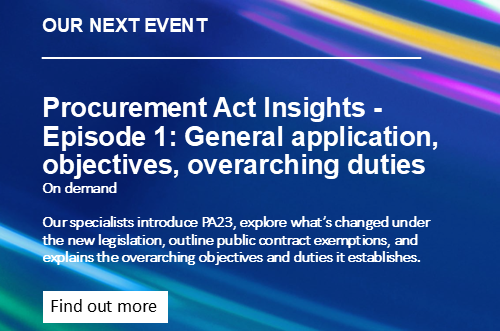- Details
When procurement law and contracts for interests in land meet
 Colin Ricciardiello provides a case law update examining cases that have examined the overlap between a requirement to procure and a contract for the disposal of an interest in land.
Colin Ricciardiello provides a case law update examining cases that have examined the overlap between a requirement to procure and a contract for the disposal of an interest in land.
There ought to be no procurement issue when these two elements come together in cases where one of the parties is a contracting authority within the meaning of The Public Contracts Regulations 2015 (“PCR”) as the PCR does not apply to contracts for interests in land. The PCR applies to “public contracts” which are defined as “… contracts for pecuniary interest concluded in writing between one or more economic operators and one or more contracting authorities and having as their objective the execution of works, the supply of products or the provision of services”.
Equally, the position should be straightforward under the Concession Contracts Regulations 2016 (“CCR”) as there is a specific exemption in Regulation 10(11) (a) which states that the CCR does not apply to services concession contracts for: “the acquisition or rental, by whatever financial means, of land, existing buildings or other immovable property or which concern interests in or rights over any of them”.
The issue that has arisen is in cases where the contract for disposal of land is also part of a wider development agreement under which the transferred interest may also be a “public works contract”, being contracts which have as their object the execution of works/design and which currently exceed £4.7m. Those activities are set out in Schedule 2 of the PCR and include construction of new buildings, restoration works and common repairs.
Similarly, under the CCR there may be an overlap if the land transaction also amounts to: a “works concession contract” – being one for a pecuniary interest that entrusts the execution of works in consideration of the right to exploit the works or; a “services concession contract” – namely a contract for a pecuniary interest under which the contracting authority entrusts the provision and management of services (other than for works), the consideration for which is the right to exploit the services provided under the contract.
There have been a number of cases which have examined the overlap between a requirement to procure and a contract for the disposal of an interest in land. The purpose of this article is to examine some of the more recent prominent cases.
Faraday Developments Ltd v West Berkshire Council[1]
Here, the contract was a development agreement which involved disposal of a development site. The Council went through a S.123[2] process (but not a procedure as if it was a public works contract). As a result, a development agreement was made with St Modwen Developments Ltd.
The Council decided that the agreement was not a public works contract but was alive to the issue and so published a precautionary VEAT notice[3]. In that notice the Council described the object of the agreement as “an exempt land transaction”.
The agreement gave St Modwen the option to draw down parcels of land by giving notice to take a grant of a long lease or transfer of the freehold. If it chose not to do either, it was under no obligation to execute any works. However, if it did then service of that notice constituted a binding contract for the grant or sale and on completion it was obliged to build and develop. The Court of Appeal decided that it was necessary to look at the arrangements as a whole and their commercial substance. From that perspective the agreement was not a public works contract when it was entered into because St Modwen was not under an immediate enforceable obligation to undertake works, it would though become obliged once the option to draw down was exercised. Therefore, on entering into the agreement, the Council “… had committed itself contractually, without any further steps being required of it, to a transaction that will fully satisfy the requirements of a “public works contract”. It had committed itself to procuring the development from St Modwen” (paragraph 61). Entering into the agreement was held to be an actual and anticipatory breach of the PCR and a breach of public law as it meant that the Council had agreed to act unlawfully in the future by not holding a procurement after the option was exercised.
At first it does not appear that Faraday sits too well with the Section 106[4] agreement considered in R (Midlands Co-op) v Birmingham City Council[5]. Both involved contingent developer obligations. However, the Court in Faraday distinguished the cases by holding that the Section 106 agreement in Birmingham was very different to the Faraday private law contractual development obligation. Section 106 agreements have a distinct status and role in the statutory planning scheme for regulating the development of land for which planning permission is granted. Also, the Council in Birmingham was not trying to commission the works but mitigating the effects of the development if it was undertaken and, in so doing, it was discharging its regulatory (and statutory) planning function, not embarking on contractual arrangements for development of its land.
AEW Europe LLP v Basingstoke & Deane Borough Council & NewRiver Leisure Ltd[6]
In this case the Council did carry out a procurement procedure to redevelop and regenerate a leisure park. Only two economic operators submitted initial tenders. The successful one ultimately offered a more detailed tender and following negotiations (and post the final tender stage) a development agreement was signed which contemplated a bolder regeneration and increased retail element than envisaged at the procurement stage.
The Claimant, AEW, did not participate in the procurement. It had bought nearby retail investment properties and had a commercial interest in preventing the Council’s retail development. AEW sought to declare the development agreement ineffective as it so radically departed from the contract sought in the procurement and required a fresh procurement. As an aside, there was a live but undetermined issue as to whether AEW had standing to bring a claim at all – no duty could be owed to an economic operator who did not participate in the procurement[7].
Comparing the OJEU original notice and the development agreement, the court held that they were sufficiently related so the notice was effective and sparked a competition. On that basis the claim for a declaration of ineffectiveness for failing to advertise the procurement failed.
European Commission v Republic of Austria[8]
The issue here was whether a contracting authority’s taking of a long-term lease amounted to a public works contract which should have been the subject of a competitive procedure. That was based on the definition of a works contract which extends to cases where the works correspond to the requirements specified by the contracting authority who exercises decisive influence on the type or design of the work. That element of control also featured in Faraday.
It was held that the lease was not a public works contract because:
- the lease provided for the option of letting additional space, not the construction of that space. That option did not have a decisive influence on the design;
- the design of additional floors and connecting bridges was envisaged in plans which existed before the lease negotiations – and so the Authority could not have exercised a decisive influence on that pre-existing aspect of the design;
- in order to be of decisive influence, it would be necessary to influence the architectural structure e.g. size/external walls; or its specifications for the interior were very specific and detailed requirements. If not, then the influence is unlikely to be decisive;
- the conclusion of a long lease was not unusual, and it was normal for a tenant to makes its specification wishes clear in respect of new build or an upgrade in cases where a tenant changes; and
- overall, the Authority’s stipulations did not exceed what a tenant normally requires.
Peters v London Borough of Haringey & Lendlease Europe Holdings Ltd[9]
In this important ruling, it was confirmed that LLP structures (rather than a company) can be used to create joint venture vehicles with private sector entities to undertake regeneration projects.
Whilst not the only regeneration power available to the Council, a point in issue was that the general power of competence under The Localism Act 2011 was subject to Section 4(2) of that Act so that where a local authority does things for a commercial purpose it must do them through a company and so (it was argued) that excluded an LLP structure.
Here it was held that: the commercial purpose of money making was not the Authority’s dominant purpose – those purposes included the best/only means to use the Council’s land and buildings to achieve regeneration (not commercial property development), job creation and newly built houses. In particular: the relevant purpose was that of the Council not the LLP or its private sector partner. That was an important finding as the definition of an LLP includes an entity who has the objective of making a profit; mere profit making did not in itself equal a commercial purpose; if there were separate purposes, then the company only requirement under Section 4(2) would apply where the dominant purpose was a commercial one.
Ocean Outdoor v London Borough of Hammersmith[10]
This was the first case on the CCR and concerned the Council’s decision to enter a lease for two plots of land it owned and the operation of two advertising screens.
The Council sought competitive bids for new leases of the plots and the winner’s bid offered much higher rent than the Claimant’s bid. Ocean argued that the grant of the leases were a “Services Concession Contracts” which should been the subject of a procedure under the CCR.
The Court of Appeal held that, in line with established EU case law, “Services” are those which otherwise would have to be provided by the Authority as part of its statutory obligations or furtherance of its strategic objectives. The Authority had no statutory obligation to provide advertising services and they were not provided on the Authority’s behalf; it is for the challenger to prove that the procurement rules apply and not for the Authority to displace an assumption that they do; the paradigm concession contract will involve third party members of the public for whom the Authority is obliged to provide services. Here the third parties were the advertisers who had no connection with the Authority and the money they paid to the Authority Tenant had nothing to do with the Council who had a separate entitlement to rent unrelated to the advertising revenue received by the tenant.
Importantly, the Regulation 10(1)(a) land exemption was held to be applicable – the leases were genuine and not contracts to provide advertising services; they granted exclusive possession; a fixed rent was paid and was not conditional on or affected by a type or level of advertising sold by the Tenant.
Conclusions
When it comes to development agreements, since Faraday it seems clear that: deferred or contingent development obligations in themselves will not prevent such an agreement from being a public works contract; whilst the PCR applies, the protection offered by a VEAT notice will not necessarily be secured if the notice lacks the required detail[11] as occurred in Faraday. A consequence which led to the first declaration of ineffectiveness ever made in the UK.
The Republic of Austria decision usefully illustrates and alerts to the possibility of over specified, and perhaps out of the ordinary, Buyer/Tenant requirements leading to the unintended creation of a public works contract.
Peters and Haringey serves to illustrate how the more flexible and greater control offered by an LLP structure is permissible in the regeneration area but if that is the vehicle chosen, then it would be prudent to have a detailed internal account of the public body’s regeneration purpose in order to show that regeneration was not predominantly for commercial reasons.
It seems clear that even if the rent payable in Ocean was a turnover one, the land exemption would still apply.
Post Brexit, even after the current procurement regime is replaced as anticipated, the requirement to tender for the equivalent of public works contracts will remain. With that in mind, and the emphasis on public authorities to regenerate through development agreements and otherwise (in order to and make the most of their land holdings), the principles in these key cases are likely to remain relevant.
Colin Ricciardiello is a Partner at Sharpe Pritchard.
[1] Court of Appeal [2018] EWCA Civ 2532
[2] Section 123 of The Local Government Act 1972 under which there is a duty on the Authority to achieve the best price reasonably obtainable when disposing of an interest in land.
[3] A voluntary ex ante notice under Regulation 99 (3) of the PCR. If the VEAT procedure is complied with then that should disapply the first ground of ineffectiveness, being the most obvious “penalty” for directly awarding a contract in breach of the PCR.
[4] Section 106 of The Town & Country Planning Act 1990.
[5] [2012] EWHC 620 (Admin) where Tesco agreed to replace/rebuild community facilities if its proposed redevelopment caused the existing facilities to be lost. The Court held that this was not an enforceable contractual obligation as it was up to Tesco to decide on whether it should redevelop and if it did not then there was no obligation to replace/rebuild.
[6] [2019] EWHC 2050 (TCC)
[7] In Royal Cornwall Hospitals NHS Trust v. Cornwall Council [2019] EWHC 2211 the court decided no duties were owed to an economic operator who did not participate in a procurement and, in consequence, was unbale to show that it suffered or risked suffering any actionable loss as required by Regulation 91 of the PCR.
[8] (Case C-537 /19). See also a link to a more detailed article on this decision.
[9] [2018] EWHC 192
[10] [2019] EWCA Civ 1642.
[11] The emphasis on the exempt land transaction element in the VEAT notice was held to be “…. more than mere over-simplification. It was incorrect, or at best misleading. The development agreement extends considerably further than a transaction for the disposal or transfer of land. It contains intricate provisions for the design and execution of a large development, which it was envisaged and intended that St Modwen would carry out”.
For further insight and resources on local government legal issues from Sharpe Pritchard, please visit the SharpeEdge page by clicking on the banner below.
This article is for general awareness only and does not constitute legal or professional advice. The law may have changed since this page was first published. If you would like further advice and assistance in relation to any issue raised in this article, please contact us by telephone or email
|
Click here to view our archived articles or search below.
|
|
ABOUT SHARPE PRITCHARD
We are a national firm of public law specialists, serving local authorities, other public sector organisations and registered social landlords, as well as commercial clients and the third sector. Our team advises on a wide range of public law matters, spanning electoral law, procurement, construction, infrastructure, data protection and information law, planning and dispute resolution, to name a few key specialisms. All public sector organisations have a route to instruct us through the various frameworks we are appointed to. To find out more about our services, please click here.
|
|
OUR RECENT ARTICLES
December 10, 2025
Sharpe Pritchard appointed to £60m London Boroughs’ Legal Alliance frameworkSharpe Pritchard, one of the UK’s leading public law firms, has been re-appointed to the London Boroughs’ Legal Alliance (LBLA) Solicitors Panel.
November 20, 2025
Strengthening the standards and conduct framework for local authorities in EnglandJames Berry offers his insight into how the proposed changes to standards and conduct rules will affect local authorities.
November 04, 2025
Procuring and operating open frameworks under the Procurement Act 2023Chantelle Pink offers advice to authorities on open frameworks and how to procure them.
October 31, 2025
Building Solar – 5 Top Tips for Solar Farm Construction ContractsSolar farm construction contracts are in focus following fascinating insights into the continuing global uptake and expansion of renewables, and particularly solar, within the 2025 mid-year report of Ember, a global energy think tank.
|
|
OUR KEY LOCAL GOVERNMENT CONTACTS
|
||
|
Partner 020 7406 4600 Find out more |
||
|
Partner 020 7406 4600 Find out more |
||
|
Rachel Murray-Smith Partner 020 7406 4600 Find out more |







 Catherine Newman
Catherine Newman
